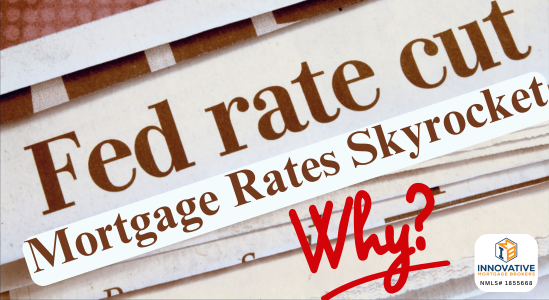What happens when too much leverage enters the safest market in the world. The bond…
The Fed Cut Rates: Mortgage Rates Jump
A look at how investor sentiment, not the Fed, drives long-term mortgage interest.
When the Federal Reserve announces that it’s lowering the federal funds rate—like this week by 0.25%—it’s easy to assume that all other interest rates, including mortgage rates, will soon follow suit. After all, if the cost of borrowing money is going down, why wouldn’t mortgage rates drop too? But, as many consumers discover, mortgage rates don’t always march in lockstep with the Fed’s moves. In fact, it’s not unusual to see mortgage rates inch upwards on the very same day the Fed announces a rate cut.
If this seems counterintuitive, you’re not alone. Let’s break down how the Federal Reserve’s decisions impact the financial landscape, why mortgage rates are influenced by different forces, and what you should keep in mind as a potential homebuyer or refinancer.
The Role of the Federal Reserve and the Federal Funds Rate
First, it’s essential to understand exactly what the Federal Reserve does in terms of interest rates. The Fed sets the federal funds rate, which is the rate at which banks lend money to one another overnight. This rate is incredibly short-term—think hours or days—and it influences the overall liquidity in the banking system. While changes to the federal funds rate can affect consumer interest rates (such as credit card APRs, auto loans, and home equity lines of credit), it’s not a direct line to mortgage rates.
Mortgage Rates Are Not Set by the Fed
Mortgage rates are tied to the long-term bond market, not the overnight lending rate controlled by the Federal Reserve. Typically, mortgage rates follow the yield on the 10-year Treasury bond. When investors buy 10-year Treasuries in large amounts, the yield (or interest rate on those bonds) tends to drop, and mortgage rates often follow. Conversely, when investors sell off Treasuries, yields rise—and mortgage rates often trend upward as well.
In other words, mortgage rates are much more about investor sentiment, inflation expectations, and the general economic outlook than they are about the Fed’s short-term interest rate adjustments.
Market Reactions and Investor Sentiment
When the Fed announces a rate cut, it’s usually because they want to stimulate the economy or counteract potential slowdowns. Investors pay close attention not just to the fact that the Fed cut rates, but to what the central bank says about the economy in its accompanying statements. Are they worried about inflation? Do they anticipate a slowdown in economic growth? Any hints of uncertainty or persistent inflation fears might actually drive investors to sell off bonds.
If investors anticipate stronger long-term inflation or aren’t convinced the Fed is doing enough to manage economic headwinds, they may demand higher yields on their long-term investments. With the cost of borrowing seen as potentially rising in the future—or at least not falling in a straightforward manner—mortgage rates can edge upward even on the same day the Fed lowers the federal funds rate.
Supply, Demand, and the Global Economy
Mortgage rates are also influenced by global financial conditions. Investors from around the world buy and sell U.S. Treasury bonds, mortgage-backed securities, and other fixed-income products. A sudden change in global sentiment—maybe due to geopolitical tensions, overseas economic reports, or sudden shifts in currency markets—can cause investors to adjust their portfolios. If more investors move out of bonds into stocks or other investments, long-term interest rates, including mortgage rates, may climb.
The “Counterintuitive” Effect
It can feel strange and frustrating: you hear that the Fed “lowered rates,” only to see mortgage interest actually rise that afternoon. But once you understand that mortgage rates aren’t directly set by the Fed, it’s easier to see why this happens. Mortgage rates respond more to market forces, investor expectations, and long-term economic indicators rather than a single, short-term rate managed by the central bank.
What Does This Mean for Homebuyers?
For individuals looking to buy or refinance a home, the lesson is clear: don’t pin your hopes on a Fed rate cut immediately reducing your mortgage costs. Instead, keep an eye on the broader financial picture. Factors like inflation reports, employment data, global economic events, and overall market sentiment tend to have a more direct impact on mortgage rates than a single Fed decision.
It’s always wise to stay in touch with a knowledgeable mortgage professional who can help you understand the current rate environment. They can provide insights into whether now might be a good time to lock in a rate, or if you might benefit from waiting. Since mortgage rates can shift day-to-day based on global financial currents, it pays to have someone on your side who can keep you informed.
Conclusion
When the Federal Reserve lowers the federal funds rate by 0.25%, it doesn’t mean mortgage rates will follow suit. Mortgage rates are part of a much more complex system driven by investor sentiment, supply and demand, inflation expectations, and global market forces. By understanding these differences, you can better navigate the world of home financing and make more informed decisions about when to lock in a mortgage rate or start a new home loan process.





